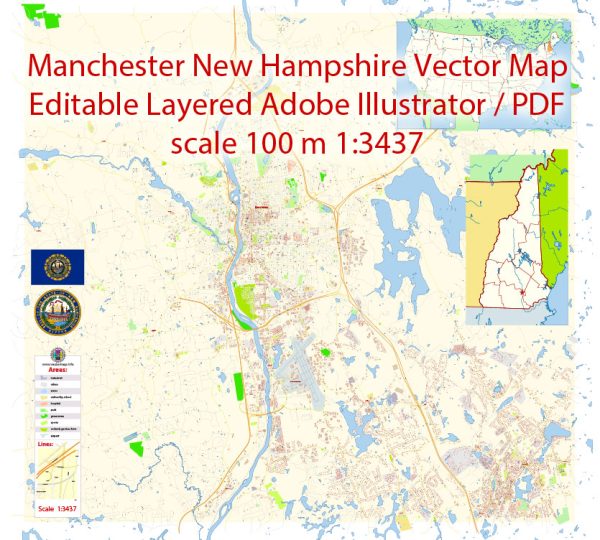Manchester, New Hampshire, has a rich history of urban development that reflects the broader trends and changes in American urbanization. Here’s a brief overview:
Early Settlement and Industrialization (18th and 19th centuries):
- Manchester was originally settled in the early 18th century by colonists. It was officially incorporated as a city in 1846.
- The city’s rapid growth and urban development were closely tied to the Industrial Revolution. Its location along the Merrimack River made it ideal for water-powered mills.
- Amoskeag Manufacturing Company, established in 1831, became one of the largest textile manufacturers in the world by the mid-19th century. The company played a crucial role in shaping Manchester’s economy and attracting a diverse population.
Mill Era and Company Town (19th and early 20th centuries):
- The Amoskeag Mills dominated the cityscape and economy. The company not only operated mills but also built housing, schools, and other facilities for its workers, creating a company town atmosphere.
- The population grew significantly as people moved to Manchester seeking employment in the mills. Immigrants, particularly from Quebec and Ireland, played a crucial role in the labor force.
- The city’s landscape was characterized by mill buildings, worker housing, and other structures associated with industrial production.
Challenges and Changes (Late 19th to mid-20th centuries):
- Manchester faced challenges with labor strikes and economic downturns, impacting the stability of the mill town model.
- The decline of the textile industry in the mid-20th century had a profound effect on Manchester. The Amoskeag Mills closed in 1936, leading to job losses and economic hardship.
- The city had to diversify its economy and adapt to post-industrial changes.
Urban Renewal and Revitalization (Mid-20th century to present):
- Like many American cities, Manchester experienced urban renewal efforts in the mid-20th century. Some historic structures were demolished, and new developments emerged.
- The city has worked to revitalize its downtown area, attracting businesses, restaurants, and cultural institutions.
- Historic preservation efforts have aimed to maintain and repurpose some of the remaining mill buildings, preserving the city’s industrial heritage.
Modern Challenges and Developments:
- Manchester continues to face challenges related to economic development, housing, and infrastructure.
- The city has invested in education, healthcare, and technology sectors, contributing to a more diverse economic base.
- Ongoing efforts focus on creating a vibrant and sustainable urban environment while preserving the historical character of certain neighborhoods.
Manchester’s history reflects the broader patterns of industrialization, deindustrialization, and urban renewal that have shaped many American cities. The city’s ability to adapt to changing economic conditions and embrace new opportunities will likely play a crucial role in its future development.


 Author: Kirill Shrayber, Ph.D.
Author: Kirill Shrayber, Ph.D.